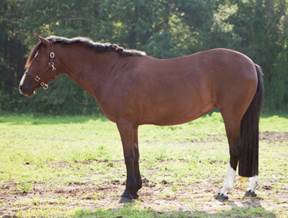How to Keep Weight off Your Horse:
Managing the Easy Keeper

By: Dr. Lydia Gray
Does your horse:
- Gain weight eating air?
- Founder every spring on grass?
- Have a cresty neck?
The first sign, obesity, means a horse has a body condition score of 7 or above on a scale of 1 = emaciated and 9 = obese. The term "regional adiposity" refers to the cresty neck and other fat pads EMS horses have: behind the shoulder, at the wither, above the tail head, over the eyes, and in the sheath of male horses. The second sign, insulin resistance, is the failure of tissues to respond appropriately to insulin. Insulin is a hormone secreted by the pancreas that stimulates the uptake of glucose (sugar) by tissues when glucose is abundant, such as after a meal. Finally, the third sign, laminitis, is inflammation of the sensitive laminae in the horse’s hoof, called “founder" as it progresses in severity.
Although there is a strong genetic influence to EMS, obesity is the primary problem that sets off the cascade of metabolic abnormalities. Here is a list of breeds especially prone to EMS:
- Morgans
- Saddlebreds
- Paso Finos
- Peruvian Pasos
- domesticated Spanish Mustangs
- certain warmblood lines
- some pony breeds
Once a horse is diagnosed with EMS--through physical appearance, routine blood tests, and specific insulin and glucose tests--the treatment is simple but not easy: reverse the obesity. Getting a horse to lose weight requires a three-pronged approach:
- Increase exercise
- Feed a strict diet
- Supplement as necessary
Here are some guidelines for increasing exercise, which has been shown to improve insulin sensitivity itself. First, if your horse has already developed laminitis, force him to exercise only under the close supervision of your veterinarian. Second, increase the workload of any horse slowly and gradually build up the time and intensity. Third, understand that turnout does not equal exercise.
Feed a strict diet
Feeding an EMS horse correctly takes a bit more effort. In general, these horses should be taken completely off pasture and only fed hay for forage. In the past, experts recommended this hay be analyzed to make sure non-structural carbohydrates were less than 10-12%. Now they recommend hay be analyzed for water-soluble carbohydrates, ethanol-soluble carbohydrates, and starch.
Next, stop feeding grain, especially if it is a sweet feed loaded with molasses (sugar). Put the horse on a ration balancer or multi-vitamin/mineral supplement so that minimum daily nutritional requirements are met. Sometimes balancing the diet for trace minerals crucial to proper metabolism is all that is required to restore an EMS horse to health.
Supplement as necessary
Finally, consider if adding additional ingredients from metabolic supplements may be beneficial. For example, EMS is associated with a high degree of oxidative stress throughout the body, so experts recommend feeding antioxidants such as Vitamin E to combat these dangerous free radicals. The minerals chromium and magnesium, as well as the vitamin biotin and the amino acid taurine have all been shown to improve insulin sensitivity, and may help support healthy metabolic function. A startling discovery in a Bethesda, Maryland, USDA lab suggests cinnamon may lower blood sugar levels, and is being used by human diabetics. Other herbs such as Gymnema silvestri, Bitter melon, fenugreek, Banaba leaf and others may also help in the regulation of blood sugar.
SmartPak strongly encourages you to consult your veterinarian regarding specific questions about your horse's health. This information is not intended to diagnose or treat any disease, and is purely educational.